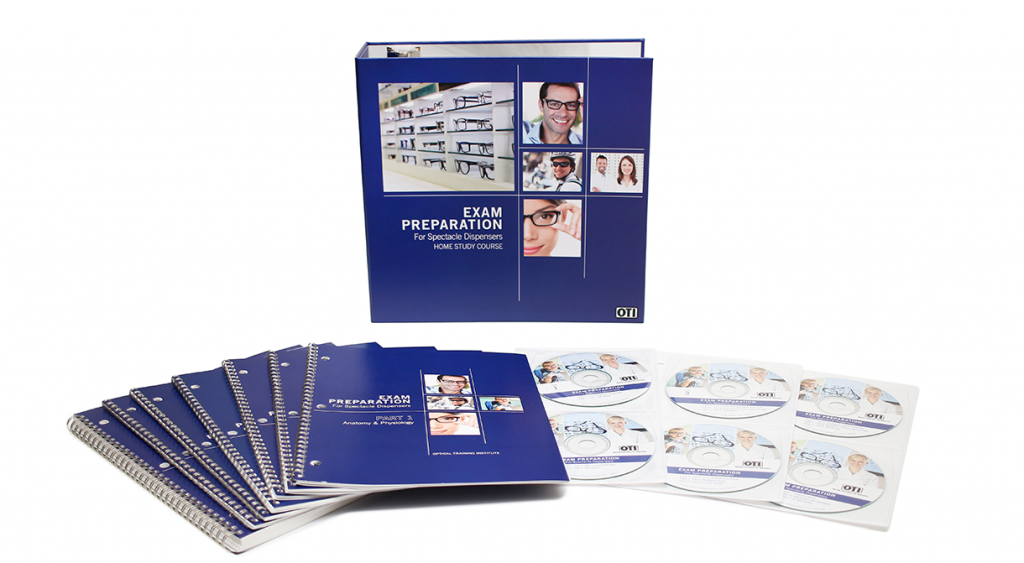
Six workbooks and audio tracks linked to the workbooks logically and concisely cover the subjects you’ll need to know, with explanations, tables, charts, diagrams, exercises, and over 150 practice test questions – all designed to make you feel fully prepared and totally confident. Audios are available online and included as six CDs.
ORDER NOWWhat You Will Learn from This Course
This section surveys the major anatomical features of the human eye along with their physiological function. It includes a discussion of the cornea, iris, pupil, crystalline lens, suspensory ligaments, aqueous and vitreous humor, retina, rods and cones, choroid, optic nerve, macula, sclera, and ciliary body. Certain pathologies such as glaucoma, cataract, and scotoma are described. The various ametropias which are usually correctable with spectacle lenses are surveyed. Phorias and tropias will be presented and discussed. A glossary of important covered will conclude this session.
Here we begin with a discussion of the metric system of measurement followed by a review of basic mathematical principles. The electromagnetic spectrum, the nature and propagation of visible light, and index of refraction is presented. This section concludes with a discussion of prism, prism diopter, the perception of lenses as prism, and Prentice’s Rule.
Covers the actual shape and deign of modern prescription ophthalmic lenses. It will include a discussion of spheres and radius of curvature. Corrected curve lenses, the rationale for the use of commonly recommended base curves, and the importance of the routine use of the “lens clock” will be presented. Cylindrical shapes and their use in prescription ophthalmic lenses for the correction of astigmatism are discussed. The power cross will be covered to aid in determining the power of compound lenses in the various meridians and to better understand lens transposition. Finally, vertex distance compensation for higher powered lenses will be covered.
Surveys various styles of multifocal lenses currently available to include flat top, executive, ultex, blended, progressive-the relative merits and uses of each will be outlined. The concept of the reading addition and “image jump” along with a rationale for the development of improved multifocal lens designs will be discussed along with a comparison of fused and one piece lenses. Bicentric grinding or “Slab-off” is included in this session along with a discussion of spectacle lenses which are used for the correction of aphakia.
Surveys various styles of multifocal lenses currently available to include flat top, executive, ultex, blended, progressive-the relative merits and uses of each will be outlined. The concept of the reading addition and “image jump” along with a rationale for the development of improved multifocal lens designs will be discussed along with a comparison of fused and one piece lenses. Bicentric grinding or “Slab-off” is included in this session along with a discussion of spectacle lenses which are used for the correction of aphakia.
Surveys various styles of multifocal lenses currently available to include flat top, executive, ultex, blended, progressive-the relative merits and uses of each will be outlined. The concept of the reading addition and “image jump” along with a rationale for the development of improved multifocal lens designs will be discussed along with a comparison of fused and one piece lenses. Bicentric grinding or “Slab-off” is included in this session along with a discussion of spectacle lenses which are used for the correction of aphakia.
Begins with a study of the lensometer to include a survey of its principal parts as will as a summary of the measurements it is capable of reading. Includes a step by step procedure for verifying a lens from a known prescription as well known as neutralizing a lens from an unknown prescription. The methods of interpreting prism power as well as the direction of its base are followed by a description of when and how to “split” vertical prism for improved cosmetics and patient comfort. A survey and brief description of some basic tools used in the optical dispensary concludes this section.
The governmental and non-governmental regulatory agencies are surveyed to include ANSI, OSHA, FDA, and ASTM. An abbreviated table of ANSI Standards is included to list the most commonly referenced tolerances for prescription ophthalmic lenses along with a table of other ANSI publications of interest to the optical dispenser. Professional liability for the products, services, and information dispensed to the public is addressed. Emphasis is placed on maintaining adequate, up-to-date product knowledge and of demonstrating genuine concern for the needs and well-being of the patient.
Choose one of the best preparation courses, which is proven to increase your chances of passing the exam on your first try.
ORDER NOW